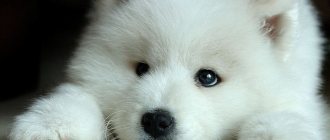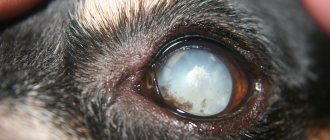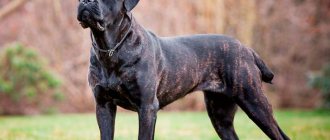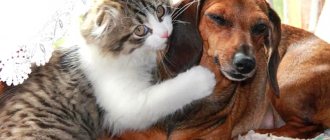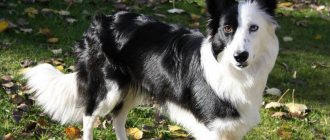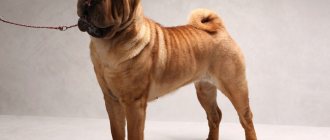The Rottweiler is a large, strong dog with a fighting appearance and a loyal character. It is considered one of the most aggressive breeds, as it fearlessly rushes to protect its owner from any threats. With proper upbringing, he will become a true friend, affectionate and faithful.
- Head
- Raising a Rottweiler
- Care
Breed traits
Breed traits (on a 5-point scale)
| Rottweiler | |||
| Activity | in the house | 2.8 | |
| on the street | 3.7 | ||
| Obedience | training | 3.7 | |
| strangers | 3.9 | ||
| Domination | in family | 3 | |
| over dogs | 4 | ||
| Defending your territory | from people | 3.8 | |
| from dogs | 4 | ||
| Sociability | in family | 4.4 | |
| with strangers | 2.6 | ||
| with dogs | 2.6 | ||
| Concentration | in family | 1.7 | |
| in front of strangers | 2.7 | ||
| with dogs | 2.6 | ||
| Aggressiveness | in family | 1.8 | |
| to strangers | 3.2 | ||
| to the dogs | 3.5 | ||
| to cats | 3.5 | ||
| Family behavior | calmness | 4.2 | |
| demand for affection | 4.2 | ||
| excitability | 3.5 | ||
| playfulness | 3.8 | ||
| excessive barking | 1.9 | ||
| behavioral breakdowns | 2.1 | ||
| Tolerance for children | up to 4 years | 3.2 | |
| over 4 years old | 3.5 | ||
| Institutional use | watchman | 4.6 | |
| bodyguard | 4.1 | ||
This breed is often compared to the following dog breeds: German Shepherd, Cane Corso, Labrador Retriever, American Staffordshire Terrier, Doberman Pinscher.
Rottweilers make reliable guards, the best guides, and rescuers who risk their lives for people. This is an intelligent, independent and self-confident dog. But it is not suitable for everyone, as it requires serious education. Before getting such a pet, you need to study everything about their features, pros and cons.
The photographs show what a beautiful, hardy dog he is:
Rottweiler
Rottweiler
Historical reference
The Rottweiler descends from ancient mastiff-like herding dogs. Experts say that breeding began in the 6th century. BC e. in Babylon, from where the breed penetrated into Ancient Egypt, and then became a favorite of the Roman legionnaires, who dressed the Rotti in armor and released it onto the battlefield, terrifying the enemy. Legionnaires brought the dog to Europe, namely to Southern Germany, in the first half of the 2nd millennium BC. e.
The breed received its official calling in 1901 from the First German Union of Police Dogs. In 1914, immigrants from Rottweil entered Russian territory.
Rottweil butchers trusted the guarding qualities of their Rottweilers so much that they hung bags containing the day's earnings around their necks and sent them home. Thanks to the bloodthirsty reputation of the breed, no one dared to approach the brave dogs.
Rottweiler - general characteristics of the breed
Rottweilers are considered angry, aggressive dogs. In fact, such character traits are inherent only in animals that have not received the right upbringing. This breed was bred for serious work associated with danger, often in extreme conditions. Therefore, the main characteristics are considered endurance, courage, and strength. Intelligence is visible in the dog's gaze; they are self-confident, loyal to their owner and ready to serve him.
They are natural guards, so they will be aggressive, protecting their owner from danger. But with proper training, the result is a peaceful and affectionate pet. The main thing is to accustom the dog to calm behavior and obedience. The owner of a Rottweiler must be a strong person who can gain authority. This is a smart dog, it strives to dominate. If there is no leader in the family where this pet is kept, the Rottweiler will take his place.
Representatives of the breed are the best watchmen and security guards, guides and rescuers. They will bravely protect their owner from any dangers. They monitor the safety of children and property, and are not afraid to attack even an armed bandit. These dogs serve in the police and rescue services. They skillfully search for drugs, explosives, catch and disarm criminals. Due to their strength and endurance, Rottweilers can carry loads.
The service qualities of the breed are visible in the photographs:
On the attack...
Item protection
A description of the characteristics of the breed can be found in the table:
| Options | Characteristic |
| Weight | Females 42-48 kg, males - 47-54 kg |
| Height at withers | Females – 56-63 cm, males – 61-70 cm |
| Lifespan | On average they live 11-13 years |
| Intelligence | Tall, easy to train |
| Activity | Very efficient, energetic, resilient |
| Aggressiveness | Above average |
| Need for care | Easy care, light shedding |
| Working qualities | Security guard, watchman, guide, rescuer, draft animal |
| Puppy price | From 5 to 30 thousand rubles |
Interesting facts about the breed
Rottweilers are versatile dogs and there are many conflicting opinions about them. There are several interesting facts about this breed.
- These dogs take a long time to reach psychological and physical maturity. The Rottweiler becomes an adult by the age of 2 years.
- A Rottweiler can cause a lot of problems for an inexperienced owner. Without proper upbringing, he will become dangerous both for him and for those around him. For this reason, inexperienced dog breeders should not get such a dog.
- These dogs do not tolerate heat well. But they are tolerant of cold thanks to their thick undercoat.
- They often fight with other dogs because they feel like they are a rival. They treat small animals with contempt, but they can hunt them.
- Rottweilers can be trusted to guard money. Both before and now they are used as a safe, hiding jewelry behind the collar.
- This dog can quickly transform from a gentle, kind pet into an angry and aggressive beast if it senses danger.
- In cinema and cartoons, they are almost always negative characters.
- Previously, all Rottweilers had their tails docked. Since the end of the 20th century, docking of animals has been prohibited in the West. There is no such ban in Russia.
- There are many pictures from the times of Ancient Rome, depicting large powerful dogs - the ancestors of Rottweilers.
- These dogs don't live long. But there were cases when the Rottweiler was 15 years old. There is information about a dog that lived for 17 years.
pros
Now Rottweilers are valued as the best guards, guides, and watchmen. But they are also popular as a pet. After all, they have many advantages and positive characteristics:
- smart, quick-witted, trainable;
- strong, resilient, efficient;
- devoted, faithful, ready to serve a person, but not intrusive;
- medium size allows you to keep a Rottweiler in an apartment;
- moderate shedding, easy to care for;
- stable psyche, calm, balanced character.
Minuses
But potential aggressiveness makes this breed dangerous. Feeling threatened, the Rottweiler attacks quickly. When a dog is angry, it is impossible to pull him away; he does not feel pain. Therefore, such a pet is not suitable for everyone. Before getting a dog, you need to study what disadvantages Rottweilers have:
- stubbornness, aggressiveness;
- it is difficult to gain authority because they like to dominate;
- noisy;
- do not get along well with other animals;
- great need for high physical activity;
- the need for strict education;
- have a hard time experiencing the change of owner;
- increased salivation;
- tendency to obesity and the need for special nutrition.
The video will tell you more about the pros and cons of the breed:
Video: pros and cons of the breed
Advantages and disadvantages
- Pros:
- feel comfortable in the apartment;
- excellent external data;
- do not require troublesome maintenance;
- completely devoted to the owner, sparkling with happiness, maintaining an aura of respect;
- natural guards;
- They can run around the park tirelessly for hours.
- Minuses:
- susceptible to various diseases, especially genetic ones;
- may gain excess weight;
- Regular training, walks and training are required;
- Some individuals have excessive salivation or snoring at night.
Origin story
The ancestors of the Rottweiler are considered to be Molosser-like dogs that served the Roman legionnaires. They guarded convoys and were even used as fighting dogs, as can be seen in the pictures of those times. With Roman troops they entered Germany. There, strong, efficient dogs took root and began to be used for herding cattle and guarding.
The modern Rottweiler became known as an independent breed of dog in the 18th century. It was bred in the German town of Rottweil. Mastiffs were crossed with local herding dogs. The purpose of breeding was to obtain an obedient and hardy dog. These strong, efficient animals were used to guard carts of meat, sometimes even harnessing them to carts. Therefore, at first they were called “butcher’s dogs.” Then the name rottweiler appeared.
In the 19th century, with the advent of the railroad, the need for such helpers disappeared, and Rottweilers almost disappeared. But gradually the fame of this dog as the best protector and guard spread throughout the country, and then throughout Europe. At the beginning of the 20th century, representatives of this breed were brought to Russia. At first, Rottweilers were used for herding livestock and in police service. Then they began to breed more evil individuals to guard prisoners in the camps.
Since the 20s of the 20th century, the Rottweiler breed has received official recognition as a service dog. According to the ICF classification, they were classified as Molossers, a subsection of Mastiffs. In Europe, Rottweilers were bred as pets, paying more attention to such characteristics as loyalty and goodwill.
In Russia, evil guards and guard dogs were bred, which gained fame as rude and aggressive dogs. Only in the 80s did representatives of the breed with a calm, peaceful character appear, brought from Germany. Now Rottweilers are one of the most popular dog breeds all over the world.
Interesting Facts
- The pressure of the Rottweiler's jaws reaches 22 atmospheres (the pit bull and the German shepherd have a less powerful grip).
- Rottweiler attacks on people accounted for 16% of all deaths from dog bites in America (statistical studies have been conducted over the past 20 years).
- A Rottweiler named Buster saved the life of an 8-year-old American girl from Idaho. She fell from her horse, injured her head and lost consciousness. There was only a faithful dog nearby. He ran to the owners of the nearest farm and led them to the girl. Doctors operated on the little rider in time, and she remained alive.
- Rottweilers are officially banned in Israel, Portugal, Spain, the USA and France.
- In the German town of Rottweil there is a bronze statue of a Rottweiler that is considered a local landmark.
- Rottweilers serve in the Russian police (standard service life is 8 years). Rottweilers are also used to guard camps and escort prisoners.
Description of the appearance of the Rottweiler breed
This breed is one of the twenty most popular, so almost everyone knows what Rottweilers look like. This is a strong, powerful dog, above average height, with a well-proportioned, muscular body. Males are larger, their height at the withers is 61-70 cm, weight is about 50 kg, sometimes more. The females are smaller, but also look powerful and strong. Their height is 56-63 cm, weight – 42-45 kg. In the photo, representatives of the Rottweiler breed look impressive. This is a muscular dog that at first glance gives the impression of a reliable protector.
The modern breed standard was adopted in 2000. It did away with tail docking. The description of the appearance has hardly changed since the beginning of the 20th century. The following character traits of a Rottweiler are considered mandatory: calmness, peacefulness, confidence and lack of aggression.
Photos show what this dog should be like:
Rottweiler muzzle
Outdoors…
The place of origin of the breed is Germany. This is the classic type of Rottweiler, and the accepted standard is based on it. It does not recognize varieties, but still different countries have developed their own subtypes. They have their own characteristics:
- American ones are larger, more aggressive;
- Austrians are shorter;
- Finnish ones are lighter in color, the ears and nose are longer;
- English breeders focus on character traits: calmness, equanimity and obedience.
Head
The dog's head is large and of medium length. Between the ears it is wide, the forehead is convex, the transition from it to the nose is well defined. The cheekbones and occipital protuberance are also prominent. When the dog is calm, there should be no folds on the head. If the dog is excited, they are acceptable. The Rottweiler's ears are set high and wide apart. They are medium in size, triangular, hanging.
The eyes are medium size, dark, oval. The gaze should be attentive, calm and open, without malice. The teeth are large, scissor bite. The lips are dark, tightly fitting, the cheeks are large, but do not cover the powerful lower jaw. The nose is wide and always black.
Torso
The body of the Rottweiler is proportionally folded. The body is not stretched, the length exceeds the height by no more than 15%. The neck is of medium length, strong, muscular, the scruff and withers are well defined. It should be tight, without dewlap or folds on the chest. The chest is wide and deep.
The back is straight, the transition to the lower back is smooth. There is no waist, the lower back is slightly convex. The croup is wide and muscular. The tail is set high and continues the line of the back. Hangs in a calm state. Now, according to the standard, it is not docked. In the West they abandoned this procedure because of its pain. In Russia, docking is not prohibited; such dogs can take part in exhibitions. But fewer and fewer breeders are doing this. If the tail is docked, it should be docked short, leaving 1-2 vertebrae.
Limbs
The limbs are straight, strong, set parallel. The shoulder blades and shoulders are massive. The forelimbs are slightly shorter than the hind limbs, set wide apart. The thighs are short and the lower leg is long. The paws are gathered into a ball and arched.
Coat and color
The coat is medium length, coarse and dense. It fits well and is shiny. Slightly longer on hind legs. The undercoat is thick, dense, and short.
The Rottweiler's color should be black with brown or tan markings. This is the only color recognized by the standard. Moreover, even the location of the spots is strictly regulated:
- on the face - cheeks, eyebrows;
- on the throat, chest;
- on the inner thighs;
- on the paws.
The correct arrangement of tan marks develops in a Rottweiler with age. In puppies they may be blurry, but in an adult dog they are always clear, pure color, without white spots. All other coloring should be black. Light areas on the coat are often found in dogs before their first shedding. Sometimes white spots appear due to stress or poor diet.
The photographs show the peculiarities of the Rottweiler's coat and color:
Serious boy
Rottweiler
Disqualifying faults
There are several characteristics of the appearance and behavior of representatives of this breed, due to which they may not be allowed to be exhibited in Western countries. In Russia, the standard allows a docked tail, but other disqualifying faults are the same:
- loose eyelids;
- light or yellow eyes;
- missing several teeth;
- long or wavy hair;
- large white spots;
- many or few scorch marks;
- cowardice, aggression, disobedience.
Varieties
The description of this breed is strictly regulated in the standards.
Moreover, today there are 4 of them:
- German;
- American;
- English;
- from the Canine Federation.
It is known that in the USA, when breeding, they often used dogs that were purebred, but defective and rejected in Germany. Therefore, at the origins of their genealogy there were not the highest quality individuals.
In an attempt to improve the protective properties of the Rottweiler, they usually imported representatives of the breed that were slightly more aggressive and tall, which affected the entire line. Such dogs look much more severe than their “European” counterparts.
This practice has led to the appearance of certain genetic diseases in Rottweilers, such as articular dysplasia. If a purebred dog is healthy, this does not make him less aggressive and he also needs proper upbringing.
English Rottweilers are almost no different from the “Germans”, since standard breed parameters were used in breeding. The difference lies only in the character of the dogs. Like true Englishmen, such dogs already from 1 month of life have strong self-control, which can only be broken by the owner’s order.
The original approach to breeding in each individual country led to the emergence of other recognized and unrecognized purebred dog lines, such as Finnish, Austrian, Norwegian, Italian, etc. Each of them has its own minor characteristics caused by the geographical location and desires of the owners.
A purebred dog is allowed only one color: black with orange tan. The golden color of the Rottweiler, or any other color, is considered a departure from the standard. Exactly the same as changes in coat - long-haired dogs are also determined to be defective.
Rottweiler character
Despite their impressive and menacing appearance, Rottweilers are kind, peaceful and loyal. They can become a true friend and protector to the owner and his family members. Representatives of the breed are affectionate and obedient with them. They love to play and require human attention and love. These are energetic, active pets, capable of enduring children's pranks and always ready to defend themselves. Rottweilers love children, but only family members. It is better not to leave them alone with children; they may accidentally push or scare them.
Dogs of this breed become very attached to their owner. They do not tolerate loneliness well. Boredom can cause them to become aggressive or depressed. They are also jealous; you should not pet or treat other animals in front of your pet. Rottweilers have a hard time with a change of owner and can become uncontrollable.
At home, Rottweilers are calm, affectionate, and indulgent towards other pets, especially if they grew up together. They love to eat and lie on the couch. Family members and close friends are treated kindly. But on the street they become attentive, collected, and quickly react to any threat. They are wary of strangers, but with proper upbringing they will not show aggression. This is a very smart dog, it has high intelligence, but can be cunning and lazy.
The photo shows how good-natured this dog can become with proper upbringing:
Rottweiler with a cat
Raising a Rottweiler
But positive character traits are manifested in representatives of the breed only with proper upbringing. Rottweilers require serious training and a calm family environment. The owner must show patience and severity, but these dogs do not like aggression towards themselves or disrespect. Even if there are conflicts between family members, this will negatively affect the character and behavior of the dog.
Representatives of the breed cannot be called harmless lap dogs. When starting such a breed, you need to devote a lot of time to training. You need to start training a puppy from the first day it arrives in the house. He must immediately understand what is not allowed, where his place is. First you need to exercise for 15 minutes, rewarding your pet with treats. By 6 months, he should already know the basic commands: “Come”, “No”, “Ugh”, “Place”, “Nearby”, “Sit”, “Walk”.
An adult dog needs to be trained more seriously. He needs to be taught to be calm about noise, to find objects by smell, to take a barrier, to protect the owner. The dog must recognize the authority of the owner, go for a walk where he leads, and wait when ordered. Be sure to teach not to attack other animals and not to show aggression towards strangers.
It is advisable to take your dog through a professional training course. There are also specialized courses: ZKS (protective guard service) and UGS (controlled city dog). You can also teach a Rottweiler to herd livestock or hunt. It is better to train your pet under the guidance of a dog handler, as representatives of this breed are smart, cunning, stubborn and lazy. Only an experienced dog breeder who has experience with such breeds can handle them.
The video will tell you about the need to properly raise this dog:
Video: Briefly about the breed
Training Basics
Due to the laziness factor, a dog may refuse training, but pliability is also inherent in this breed. Accordingly, if you train your dog correctly, it will follow all commands quite well.
Training should consist of the following areas:
- development of hunting skills;
- protection of possessions;
- grazing.
Noting the fact that a dog is a fighter by nature, it can enter into unequal confrontation with its owner in the struggle for a leading position. In this case, you cannot do without the help of an experienced dog handler. Professionals with special training skills will help you cross this stage in your pet’s development with the least amount of stress and loss of relationship between the owner and the animal.
A Rottweiler whose main characteristic is watchdog skills can develop this feature even without special training. This is due to the fact that guard qualities are inherent in these dogs by nature. The dog has exceptional hearing, as well as coordination of movements, so we can say that uninvited guests are simply obliged to bypass the property guarded by Rottweilers. So in the field of security, as the education of a Rottweiler shows, dogs practically do not need training, they themselves know what to do, and then it’s a matter of technology.
Pets will always defend the territory and residents of this property, so for uninvited guests, a dangerous visit may turn out to be a not entirely pleasant side.
Content Features
If the area of your apartment allows, you can keep a Rottweiler in the city. But he feels better in a country house with a large yard. This breed is suitable for keeping in an aviary. It is necessary to provide your pet with a spacious kennel. It is important to constantly communicate with him, even if he lives on the street. The pet must feel the attention of the owner, otherwise it may become aggressive. The breed can withstand frosts down to -10˚. If it's colder outside, it's better to take the dog indoors.
With any method of keeping your pet, you need to walk at least an hour and a half a day. He needs physical activity and communication with his owner. You need to run a lot with the dog, preferably on the playground.
Care
Representatives of the breed shed once a year. They shed a little hair, so grooming does not create problems. It is recommended to comb your pet with a special brush or rubber mitt. It is enough to do this 2 times a week, during molting - daily. You can bathe no more than once every 3 months. It is easy to care for the wool - just wipe with a damp cloth.
This breed often develops tartar. Therefore, you need to brush your teeth weekly and give him special bones. It is also recommended to inspect and clean your ears several times a month. If signs of inflammation appear, you should contact your veterinarian.
Feeding
Representatives of the breed are prone to obesity, so you need to be strict when choosing a feeding diet. Dry food should be intended for medium breed dogs, preferably super-premium or holistic. It is important not to exceed the recommended serving size. It is enough to feed an adult dog twice a day. Water must be freely available around the clock.
If the owner prefers natural food, it is recommended to consult a veterinarian about what to feed the Rottweiler. It is forbidden to give pork, smoked meats, sweets, legumes, potatoes, white bread. It is not recommended to feed your pet from a common table. Be sure to make at least 50% of the diet meat and meat products. You also need cereals, vegetables, and dairy products. When feeding naturally, it is recommended to additionally give the dog vitamin supplements.
Health
In appearance, it seems that the Rottweiler is a hardy and healthy dog. But representatives of this breed have many congenital and age-related diseases. They are prone to the following pathologies:
- allergies, dermatitis, eczema;
- conjunctivitis, cataracts, keratitis;
- pancreatitis, flatulence, volvulus;
- renal failure;
- heart attack;
- hip dysplasia;
- epilepsy;
- diabetes.
Rottweilers are big eaters. They not only beg, but also steal food and pick it up on the street. Therefore, they are prone to intestinal infections and obesity.
You can learn more about caring for your pet from the video:
Video: description of the breed, maintenance and nutrition
Lifespan
It is generally accepted that Rottweilers do not live long - on average, about 8-10 years. Indeed, their impressive weight and tendency to become obese make these dogs susceptible to heart disease, diabetes and early death.
However, three factors significantly influence how long Rottweilers live:
- heredity;
- diet;
- physical exercise.
A dog with good genetics, who is properly fed and kept moving, can live up to 14 years.
Of course, by the age of ten he still becomes leisurely, preferring to eat and lie down, but if you bother him more often, walk him and prevent him from overeating, such a sedate old age in a Rottweiler can last quite a long time.
How to choose a Rottweiler puppy
To buy a purebred puppy, you need to contact a nursery or reputable breeders. The cost of these dogs in Moscow depends on the class:
- the price of pet-class puppies is 10-18 thousand rubles;
- breed class will cost 20-30 thousand rubles;
- the price of a show class puppy is more than 50 thousand.
The price of a Rottweiler without documents is 5-8 thousand. But the dog may turn out to be a mixed breed or with behavioral deficiencies. Therefore, it is recommended to buy a puppy with documents. It should be 2-3 months old. It is advisable to study reviews about the breeder in advance and become familiar with the living conditions of the dogs.
When buying a Rottweiler, you need to pay attention to ensure that the puppy is healthy. This is indicated by the following signs:
- tail straight;
- the bite is correct, the teeth are straight;
- ears and eyes without discharge;
- the coat is smooth, without dandruff;
- the stomach is not bloated;
- the skin on the abdomen is pink;
- nose black, wet;
- The baby himself is active and inquisitive.
You can also watch a video about Rottweilers. It will help you summarize all the information about the breed and decide whether it is worth getting such a dog.
Video: All about the breed
The Rottweiler is not a pet for everyone. It is not recommended to keep it in a family with small children or to get it for someone who has no experience with service dogs. Caring for such a pet is not difficult, but training requires a lot of effort. A properly raised Rottweiler will become a devoted friend and loyal protector.
Tail docking
Tail docking surgery on a Rottweiler is easier than ear cropping. Firstly, you can do without surgery.
A common way to shorten puppies' tails is with a bandage. A tourniquet or elastic band is applied at a distance of 2/3 of the entire length from the base of the tail. The tissues stop receiving nutrition and die; the tip falls off on its own within a week.
If the Rottweiler is more than 1 month old, surgery is required. Similar to the ear cropping procedure, the dog is placed on a table, inhalation ventilation is placed, and general anesthesia is administered using alcohol-chloroform vapor and antipsychotics.
The desired area on the tail is shaved and filled with antiseptic. The skin is pulled to the base and a portion is quickly cut off at the junction of the vertebrae. The excess skin is pulled back and sutured. A bandage with an antibacterial and antibiotic solution is applied on top.
Reviews
“This dog is like a cat. He loves to play and be cuddled, although he doesn’t particularly tolerate his smaller brothers and chases them around the yard. A very sweet and kind breed, it loves when people take photos with it. Incredibly obedient."
“A faithful guard, he reacts very quickly if something unexpected happens in the yard. By no means a fighting dog, as many people think. He treats strangers with caution, not allowing too much, but with us he is kind and playful. A true member of the family, courageous, confident and proud.”
“The breed is completely picky and does not require special care. It is only important to monitor your health, since problems with bones and heart are possible, at least this was the case with our baby. She doesn’t overeat and weighs a little, but proper nutrition and vitamins are simply necessary for this breed.”
Not everyone can handle a Rottweiler. Before opening the doors of the house for this smart dog, you need to realize that how the animal will grow up will directly depend on the amount of attention given to it by the owner.
There are no bad dogs, there are people who do not realize the responsibility for those they tame.
Color variations
The only acceptable standard color for a Rottweiler is black and tan..
But, besides him, from time to time dogs with non-standard colors are born, such as pure black, gray, brindle, reddish fawn, golden, white.
Also, Rottweilers may have white markings of varying sizes, located on a main, darker background.
CAREFULLY!
Any other colors other than black and tan are considered a defect in the breed: such dogs are not allowed for exhibitions or for breeding.
Nutrition
There are 2 main options: natural or ready-made food. It is advisable to choose before the Rottweiler appears in the house.
The latter eliminate the need to select the right proportions of vitamins and minerals for the dog, but nevertheless cost much more, since Rottweilers are given a premium “drying” specially created for this breed.
You cannot suddenly switch a dog from one type of food to another, as well as mix natural and dry food. This will lead to problems with the pet's gastrointestinal tract.
The diet of a Rottweiler is no less important than training, as it instills in the dog correct eating habits. This is especially important for dogs with problematic weight.
In a special place, there should always be 2 bowls - with water and food. Moreover, only liquid can be constantly available to the dog, and the second is removed 10 minutes after feeding. Bowls should be placed on a stand, at the level of the dog’s shoulders.
The frequency of meals is determined by age. A two-month-old Rottweiler needs to be fed 5-6 times a day, gradually reducing the number of diets. By the first year, meals become 3 times a day, and in adult dogs - 2.
The qualitative composition of consumed natural food should consist of 50% proteins, 30% carbohydrates and 20% fiber. There are special tables for calculating nutritional elements, depending on the age of the Rottweiler.
Raising a dog
You need to start training a Rottweiler as early as possible, since it is very important from the first day to let the puppy understand that he is not the boss in the house, but his owners.
IMPORTANT!
The first commands that should be taught to your pet should be “Place”, “No!”, “Ugh!”, “Come to me!”.
Around this time, the puppy is taught his name, as well as a diaper or litter box.
Subsequently, when the Rottweiler grows up, his training should be entrusted to a professional trainer.
You should not set your Rottweiler against other animals or people, as this can lead to the dog becoming aggressive and uncontrollable..
Possible diseases
Like many other large dogs, the Rottweiler lives no more than 10 years. However, there are exceptions to this rule. Proper care can sometimes help extend a pet's life by 4-5 years. A massive build gives the impression that the dog is in good health and is only visiting the veterinarian for vaccinations.
The lifespan of a Rottweiler is up to 10 years.
In practice, Rottweilers experience many diseases, for example:
- arthritis of the elbow and hip joints;
- Addison's syndrome (an autoimmune pathology in which the functions of the adrenal glands are disrupted);
- osteomyelitis;
- narrowing of the aortic valve;
- cataract;
- retinal atrophy;
- bleeding disorder (von Willebrand syndrome);
- volvulus.
Some Rottweilers exhibit neurological disorders, kidney failure, and congenital baldness.
